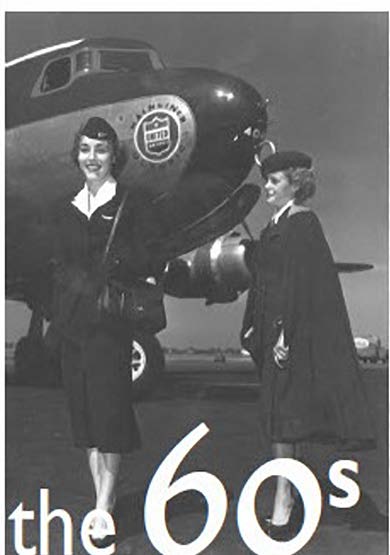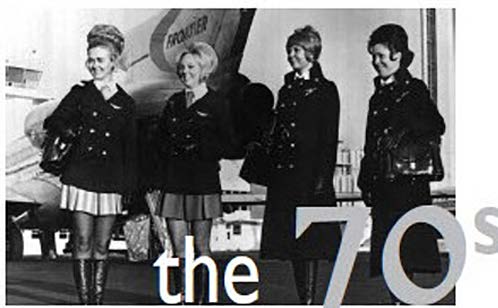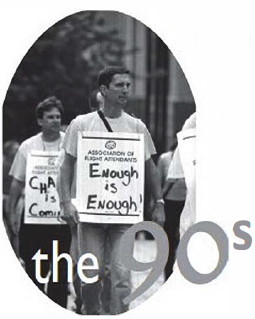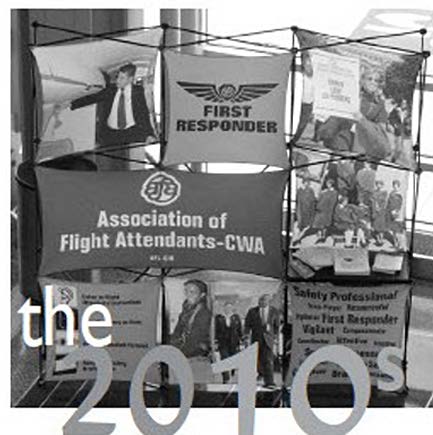 Association of Flight Attendants-CWA, AFL-CIO
Association of Flight Attendants-CWA, AFL-CIO

1945 Air Line Stewardesses Association wins recognition as first union for Flight Attendants. 
1946 First Union contract raises United Flight Attendants' monthly pay to $155, limits duty hours, sets rest periods and establishes a grievance procedure.
1947 ALSA President
Ada Brown, 30, matties and becomes a victim of United's no-marrage rule. Retires from career and union presidency.
1949 ALSA merges with the Air Line Pilots Association affiliate, the Air Line Stewards and Stewardesses Association (ALSSA).
 1951 ALSSA represents 3,300 Flight Attendants. Pilots' opposition to union shop and Flight Attendants' desire to acquire a charter with the American Federation of Labor threatens ALSSA's relationship with ALPA.
1951 ALSSA represents 3,300 Flight Attendants. Pilots' opposition to union shop and Flight Attendants' desire to acquire a charter with the American Federation of Labor threatens ALSSA's relationship with ALPA.
1952 Civil Air Adminstration requires Flight Attendants on commercial aircraft as cabin safety professionals.

1960 ALPA creates two divisions, the Pilots Division and the Steward and Stewardesses Division. Nearly half of the nation's 8,700 Flight Attendants vote to affiliate with ALPA's S & S Division.
1964 Civil Rights Act passes. Flight Attendants use Title VII of the act to challenge discriminatory policies based on gender. race, age. weight, pregnancy and marital status.
1968 Average career for Flight Attendants lasts 18 months. Mandatory resignation at ages 30-35 struck down.
 1971 Pressed by AFA. courts prohibit airlines from refusing to hire males, find United's no-marriage rule illegal.
1971 Pressed by AFA. courts prohibit airlines from refusing to hire males, find United's no-marriage rule illegal.
1973 Modern AFA is born when ALPA's S&S Division becomes the Association of Flight Attendants.
1974 Court rules Northwest Airlines must pay female Flight Attendants same scale as males.
1975 In court, AFA challenges requirement that Flight Attendants stop working upon pregnancy.
1978 Congress passes the Airline Deregulation Act. giving airlines unlimited authority over routes, scheduling and fare pricing.
1979 AFA litigation results in liberalizing airlines' weight policies.
 1981
1981 Nationwide AFA campaign helps kill FAA plan to reduce the number of cabin crew members.
1982 AFA represents 22,000 Flight Attendants at 18 carriers.
1984 Fulfilling a quest by AFA leaders since the union's founding in 1946, AFA is granted a charter by the AFL-CIO. AFA prodding results in new FAA rules requiring floor-level exit lights, less flammable cabin interiors and other cabin safety breakthroughs.
1987 Years of pressure from AFA prompts FAA to issue a policy limiting number of passenger carry-on bags.
1988 Lobbying before Congress results in smoking ban on domestic flights of two hours or less.
 1990 AFA petitions FAA to apply OSHA standards to Flight Attendants. Smoking ban goes into effect on all domestic flights.
1990 AFA petitions FAA to apply OSHA standards to Flight Attendants. Smoking ban goes into effect on all domestic flights.
1991 AFA hosts first international Flight Attendant symposium, sharing ideas with Flight Attendants from Australia, Austria, Canada, Denmark. Finland, France, Ireland. South Korea, Norway. Singapore and Sweden.
1994 AFA CHAOS campaign of intermittent work stoppages upheld in court; results in landmark contract settlement at Alaska Airlines. USAir weight program suspended following litigation by AFA. FAA issues duty-time regulations for Flight Attendants.
1995 AFA celebrates its first half century of union achievements.
1996 AFA's aggressive pursuit of safety issues following the Everglades Yalu Jet crash provokes major changes at FAA. shifting the agency's focus to safety, and resulting in closer scrutiny of safety issues at start-up carriers.
1997 AFA Board of Directors creates new organizing fund to unite all Flight Attendants in AFA.
1998 AFA sponsors carry-on baggage conference and introduces a proposed rule to the FAA restricting size and weight of carry-ons.
1999 America West Flight Attendants achieve victory with a solid first contract on the eve of a CHAOS strike after nearly IO years of struggle with a recalcitrant employer.

2000 AFA lobbies hard and wins: whistleblower protection, increased penalties for crewmember interference, study of cabin air quality, and an international smoking ban.
2001 In the wake of the September 11 attacks that killed 25 Flight Attendants on four hijacked aircraft, AFA lobbies Congress for airline security legislation and fights to protect thousands of furÂloughed Flight Attendants who lost their jobs as a result of the terrorist attacks.
2002 AFA continues to lobby for improved security. including certification for all Flight Attendants, and mandatory safety training.
2003 Decades after AFA leadership set forth their objectives in the AFA Constitution & Bylaws and after nearly a year-long battle on Capitol Hill, Congress passed Flight Attendant certification legislation.
2004 A majority of AFA members vote to merge with the 700,000 member-strong Communications Workers of America (CWA) giving members access to greater resources and expanding the union's ability to influence legislation critical to Flight Attendant jobs.
2006 Northwest Airlines Flight Attendants vote to join AFA-CWA under the AFA-CWA umbrella.
2007 AFA-CWA convinces Congress to pass legally-binding seniority protection for airline workers involved in airline mergers.The law prevents one group of airline workers from stapling another to the bottom of a seniority list and provides a process for equitable seniority integration.

AFA-CWA pressures Congress to enact and fund the first-ever comprehensive Flight Attendant fatigue study.
2009 AFA-CWA's petition to reclassify Flight Attendants from personal care and service workers to transportation and material moving occupations in the Federal Standard Occupational Classification moving Flight Attendants into the same category as pilots, mechanics and other certified aviation workers. AFA fights hard for the appointment of former AFA President Linda Puchala to the National Mediation Board (NMB) and succeeds--a promising move toward restoring the Board's integrity.

2011 25,000 United, Continental and Continental Micronesia Flight Attendants voted for AFA-CWA representation following the airlines' merger.
In the year marking the tenth anniversary of the attacks on September I I , 2001. AFA-CWA launches the campaign for recognition of Flight Attendants as First Responders.

2012 As a result of AFA-CWA advocacy at many levels of government and industry, the Transportation Security Administration announces that Known Crewmember expedited security screening will include Flight Attendants. Our inclusion in this risk-based security screening recognizes our integral role in aviation safety as first responders and the last line of defense.
In the midst of bankruptcy challenges, 1,500 Flight Attendants vote for AFA-CWA as their representative following the merger between Endeavor Air (formerly Pinnacle), Colgan and Mesaba.
2013 After 20 years of exclusion, AFA wins recognition of Flight Attendants' unique work schedules, finally allowing us access to the legal protections of FMLA.
AFA-CWA challenged and overturned national security policy. in partnership with unions representing hundreds of thousands of aviation workers, ensuring that knives and other weapons remain on the TSA prohibited items list. An intense legislative, legal and public relations strategy. coupled with AFA member mobilization left TSA no where to turn but in retreat from its misguided policy to allow knives in the cabin for the first time since September II, 200I.
AFA celebrates a tremendous victory for equality when the Supreme Court, in support of same-sex marriage, strikes down Defense of Marriage Act and California's Proposition 8.
Return to 'Your AFA' Home Page
top of page